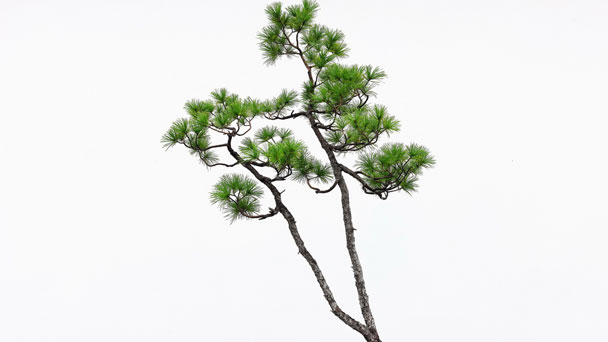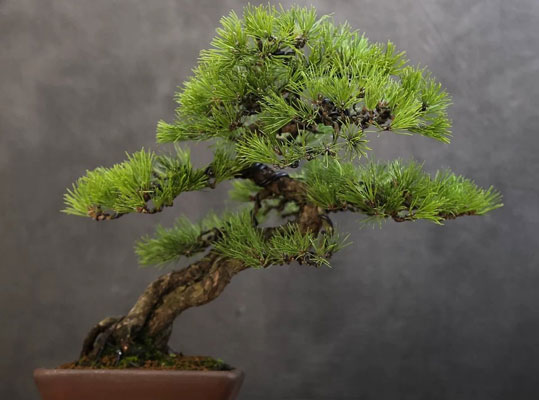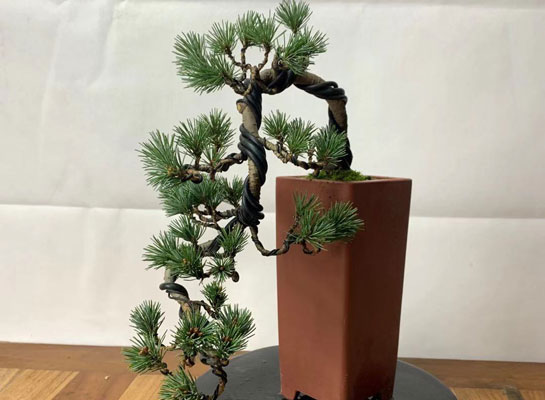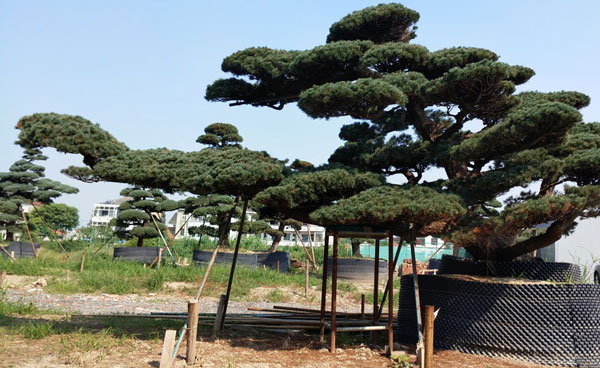Japanese White Pine: Grow & Care for Pinus Parviflora
Written by Iris
Nov 10 2021

Japanese White Pine (Pinus Parviflora) is one of the more precious bonsai materials. The leaves of Japanese White Pine(Pinus Parviflora) have a bunch of five needles, the leaves are yellowish, and the plants are relatively short. However, the density of leaf buds is higher, the growth is strong, and the branches and leaves are tight.
Read more:
How to Grow & Care for Pinus Parviflora
If you give too much fertilizer, especially nitrogen-rich fertilizer, this leads to rapid growth. Above all, the branches and shoots prefers to grow on the top of the crown. The important branches below are then often becomes weaker quickly. If you want to fertilize a lot to accelerate the growth, you have to make sure that the upper shoots do not get too strong. Pay attention that in the upper parts of the crown, the newly forming candles must be shortened early and consistently.
'Goldilocks'
This dwarf cultivar has blue-green needles frosted with gold. It should be grown where it gets good morning sun and some shade from the hot afternoon sun to keep it from burning. 'Goldilocks' grows slowly to eight feet tall with a comparable spread.
'Ogon Janome'
This is a dragon's-eye form with bright gold bands on green needles. This broadly upright cultivar will grow ten feet tall and six feet wide in ten years. The common name is Golden Bulls-eye Pine.
'Tani-mano-uki'
This dwarf cultivar has light pink candles that open to white new growth, giving a tricolor effect. It has a globular to pyramidal growth habit, and should be given shade from the hot afternoon sun. It will grow to two-and-a-half feet tall and wide in ten years.
How to Grow Japanese White Pine (Pinus Parviflora)How to Care for Japanese White Pine(Pinus Parviflora)LightSoilWaterTemperature and HumidityFertilizerPruningPests and DiseasesVarieties of Japanese White Pine(Pinus Parviflora)Japanese White Pine(Pinus Parviflora) FAQHow fast does Pinus parviflora grow?How big does a weeping white pine get?
How to Grow Japanese White Pine (Pinus Parviflora)
It is best to sow the seed in individual pots in a cold frame as soon as it is ripe if this is possible otherwise in late winter. A short stratification of 6 weeks at 4°C can improve the germination of stored seed. Plant seedlings out into their permanent positions as soon as possible and protect them for their first winter or two[8]. Plants have a very sparse root system and the sooner they are planted into their permanent positions the better they will grow. Trees should be planted into their permanent positions when they are quite small, between 30 and 90cm. We actually plant them out when they are about 5 - 10cm tall. So long as they are given a very good weed-excluding mulch they establish very well. Larger trees will check badly and hardly put on any growth for several years. This also badly affects root development and wind resistance. Cuttings. This method only works when taken from very young trees less than 10 years old. Use single leaf fascicles with the base of the short shoot. Disbudding the shoots some weeks before taking the cuttings can help. Cuttings are normally slow to grow away.Read more:
How to Grow & Care for Pinus Parviflora

How to Care for Japanese White Pine(Pinus Parviflora)
Light
For best growth, pine bonsai trees require full sun for several hours each day. The more light the tree receives, the shorter and more compact the needles will be. Leggy, elongated needles on a pine bonsai are indicative of the tree needing more sunlight.Soil
Japanese White Pine (Pinus Parviflora) prefer a well-drained porous gravelly subsoil, overlaid with a light sandy loam. They seem to be particularly happy in a soil underlaid with a porous glacial drift. In cultivation, however, they succeed very well in ordinary well-drained soil. When the plants are set in clay soil, which is often done, the soil should be thoroughly loosened by trenching or subsoil plowing, and well under drained. Any available humus, wood ashes, and well-rotted manure incorporated in the soil greatly aid in rendering it friable and porous for the roots.Water
The more sunlight and warmth your bonsai receives, the more often it will need water. More bonsai die due to improper watering than any other cause. Do not water the tree if the soil is damp or cool. Bonsai generally need to be watered every couple of days, but there is no set schedule. When the topsoil feels dry, water thoroughly and deeply. An old bonsai watering trick is to place the entire pot in a sink of water an inch or two deep. Let the water absorb from the holes in the bottom of the pot. An inexpensive moisture meter takes the guesswork out of watering. We sell them on our website. As with other pines, good drainage is essential for the Japanese White Pine.Temperature and Humidity
Pine bonsai are not suitable for growing indoors and should be grown outside year-round. Pines are hardy, frost-tolerant trees, although, when planted in containers, they should be placed in a sheltered location so they are protected from the worst of the winter weather. As with most bonsai, pine bonsai appreciate moisture and can benefit from regular misting if your climate is not naturally humid.Fertilizer
Fertilization takes place mainly from March to September with common organic fertilizers (for example Biogold, Hanagokoro, but also ordinary pine fertilizers) in solid form, which are incorporated into the substrate surface. Fertilization of this bonsai tree species can also be done with liquid fertilizer by pouring it at regular intervals. Hereby the following applies: Better to use a lower concentration in older White pines, but fertilize more often. In our bonsai nursery we administer the bonsai fertilizer via a fertilizer doser with each pouring process in low concentration.If you give too much fertilizer, especially nitrogen-rich fertilizer, this leads to rapid growth. Above all, the branches and shoots prefers to grow on the top of the crown. The important branches below are then often becomes weaker quickly. If you want to fertilize a lot to accelerate the growth, you have to make sure that the upper shoots do not get too strong. Pay attention that in the upper parts of the crown, the newly forming candles must be shortened early and consistently.
Pruning
Removal of the lower branches of Japanese white pine is a serious mistake, and, if healthy, they should be retained to the base. Pruning or disbudding can be intelligently performed to add much to the natural symmetry. The extraction or removal, early in spring, of the central or terminal bud, will tend to compel the branches which start from the side buds to spread apart and form a much denser growth. Cutting back the previous year's terminal growth to a strong bud or branchlet on the main limbs over the tree, if the plant is inclined to be thin in its branching, always produces a much denser lateral growth.Pests and Diseases
An infection of our White pine bonsai with pests could not be determined in many years. Also diseases did not occur.
Varieties of Japanese White Pine(Pinus Parviflora)
Some of the more interesting cultivars include'Goldilocks'
This dwarf cultivar has blue-green needles frosted with gold. It should be grown where it gets good morning sun and some shade from the hot afternoon sun to keep it from burning. 'Goldilocks' grows slowly to eight feet tall with a comparable spread.
'Ogon Janome'
This is a dragon's-eye form with bright gold bands on green needles. This broadly upright cultivar will grow ten feet tall and six feet wide in ten years. The common name is Golden Bulls-eye Pine.
'Tani-mano-uki'
This dwarf cultivar has light pink candles that open to white new growth, giving a tricolor effect. It has a globular to pyramidal growth habit, and should be given shade from the hot afternoon sun. It will grow to two-and-a-half feet tall and wide in ten years.

Japanese White Pine(Pinus Parviflora) FAQ
How fast does Pinus parviflora grow?
After 10 years of growth, a mature specimen will measure 12 to 15 feet (4 - 5 m) tall and wide, annual growth rate of 12 to 18 inches (30 - 45 cm)How big does a weeping white pine get?
According to pendula information, it is a short shrub with many stems. The branches grow downward and spread across the soil surface like a ground cover. However, with proper early pruning, weeping white pine can develop into a small tree up to 12 feet (3.7 m.) tall.Latest Updated
- Benefits of Bugleweed - 7 Science-backed Health Benefits
- Bugleweed Dangers & Side Effects - Is It Poisonous?
- How to Plant Evergreen Trees - What You Should Know
- When to Plant Evergreens - Grow Guide for Evergreen Trees
- 12 Wonderful Evergreen Shrubs for Your Garden
- 12 Popular Evergreen Plants with Pictures for Beginners
- When And How To Prune A Lilac Bush Like a Pro
- How to Grow & Care for Lilac Vine (Hardenbergia Violacea)
- Japanese Lilac Tree (Syringa Reticulata) Care & Propagation Guide
- Shumard Oak Pros and Cons - What to Know
Popular Articles
- Winter maintenance of Antirrhinum Majus
- How to Grow Terminalia Mantaly Tree
- How to Grow and Care for Crossostephium Chinense
- How to grow Antirrhinum Majus in spring
- Peristeria Elata (Dove Orchid) Profile: Info & Care Guide
- Underwatered Snake Plant (Sansevieria Trifasciata) - Signs And How To Fix
- How to Care for Brazilian Jasmine Plant (Mandevilla Sanderi)
- How to Grow & Care for Graptopetalum Purple Delight in Summer
- Rosa Chinensis (China Rose): Plant Growing & Care Tips
- How to Care for Baby Sun Rose (Aptenia Cordifolia)